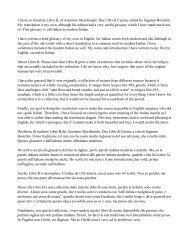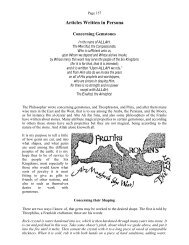How to Milk an Almond Stuff an Egg And Armor a Turnip A ...
How to Milk an Almond Stuff an Egg And Armor a Turnip A ...
How to Milk an Almond Stuff an Egg And Armor a Turnip A ...
You also want an ePaper? Increase the reach of your titles
YUMPU automatically turns print PDFs into web optimized ePapers that Google loves.
developed out of the pummelo in the West Indies in the 18 th c. (Batchelor <strong>an</strong>d Webber). Sour<br />
or<strong>an</strong>ges are still grown for use in marmalade; the usual variety is the Seville or<strong>an</strong>ge.<br />
140<br />
Artichokes <strong>an</strong>d Cardoons<br />
According <strong>to</strong> some sources, including McGee, the globe artichoke was known in classical<br />
<strong>an</strong>tiquity; others describe it as bred out of the cardoon sometime in the later middle ages,<br />
probably in Muslim Spain. The latin word is "cynara;" our word "artichoke" comes from the<br />
Arabic “al kharshûf.” Some modern sources describe the cardoon as a kind of artichoke, while<br />
others regard it as a different vegetable <strong>an</strong>cestral <strong>to</strong> the artichoke. My guess is that the classical<br />
"cynara" was the cardoon, making the globe artichoke familiar <strong>to</strong> us late period.<br />
Molasses<br />
Molasses is a residue from the process of refining sugar. Treacle was originally the name of a<br />
medical mixture one of whose ingredients was honey. It originated in classical <strong>an</strong>tiquity <strong>an</strong>d<br />
survived in<strong>to</strong> the Middle Ages; at some point molasses or sugar syrup beg<strong>an</strong> <strong>to</strong> be used instead of<br />
honey for the base. “When the production of molasses in Britain's refineries out-stripped the<br />
needs of both apothecaries <strong>an</strong>d distillers, it was sold off in its natural unmedicated state as a cheap<br />
sweetener. Its name of molasses was taken by the early settlers <strong>to</strong> America. But in Britain in the<br />
later seventeenth century the alternative term 'common treacle' came in<strong>to</strong> circulation, <strong>an</strong>d<br />
thereafter it was known simply as treacle.” (Wilson).<br />
Since, according <strong>to</strong> Wilson, Engl<strong>an</strong>d had its own sugar refineries by 1540, molasses might<br />
have been used as a sweetener in Engl<strong>an</strong>d before 1600. The word first appears in English in 1582<br />
<strong>an</strong>d all of the pre-1600 references are <strong>to</strong> its existence abroad. Molasses is, however, mentioned by<br />
Hugh Platt in the 1609 edition of Delights for Ladies; I have not been able <strong>to</strong> find a copy of <strong>an</strong><br />
earlier edition. Presumably molasses would have been used earlier in areas where sugar was<br />
grown, such as Spain, Sicily <strong>an</strong>d the Middle East.<br />
Chemical Leavenings<br />
So far as we c<strong>an</strong> discover, both baking soda <strong>an</strong>d baking powder are far out of period.<br />
According <strong>to</strong> the 1992 Old Farmer’s Alm<strong>an</strong>ac, Saleratus (Potassium Bicarbonate) was patented as<br />
a chemical leavening in 1840. Hartshorn (Ammonium Carbonate) was used for stiffening jellies<br />
by about the end of the sixteenth century (Wilson) but we have found no reference <strong>to</strong> its use as a<br />
leavening agent prior <strong>to</strong> the late 18th century.<br />
New World Foods<br />
Pota<strong>to</strong>es<br />
Sweet pota<strong>to</strong>es are described in 1555 as growing in the West Indies. By 1587 they are said <strong>to</strong><br />
be “brought out of” Spain <strong>an</strong>d Portugal, <strong>an</strong>d described as venerous (aphrodisiacal). In 1599 Ben<br />
Johnson describes something as “above all your pota<strong>to</strong>es or oyster pies.”<br />
Ordinary pota<strong>to</strong>es, according <strong>to</strong> the OED, were described in 1553 <strong>an</strong>d introduced in<strong>to</strong> Spain<br />
shortly after 1580. They reached Italy about 1585 <strong>an</strong>d were being grown in Engl<strong>an</strong>d by 1596. By<br />
1678 the pota<strong>to</strong> is described as “common in English gardens.”<br />
The Larousse gives somewhat earlier dates–1539 or 40 for the original importation in<strong>to</strong> Spain,<br />
1563 for the introduction in<strong>to</strong> Engl<strong>an</strong>d (“but its cultivation was neglected there”) <strong>an</strong>d 1586 for the





